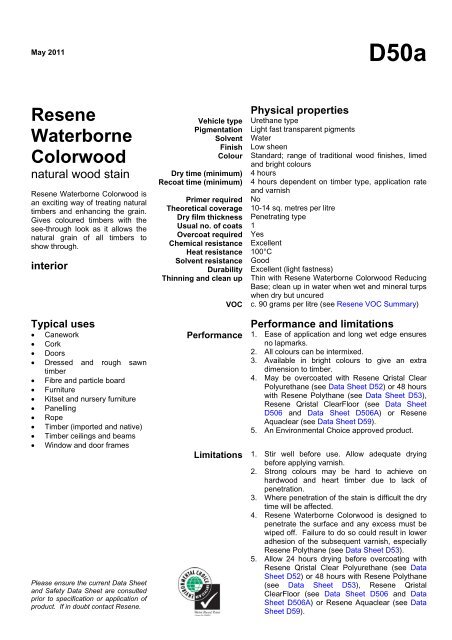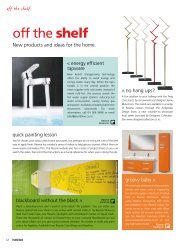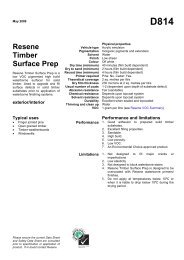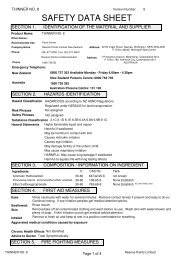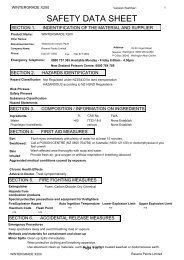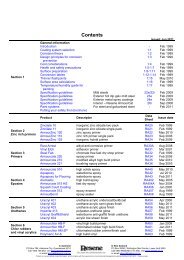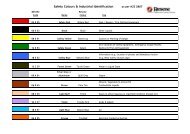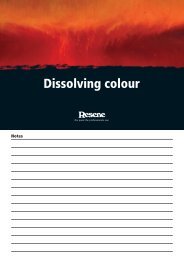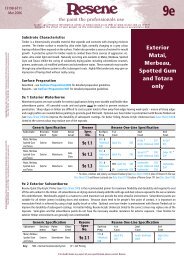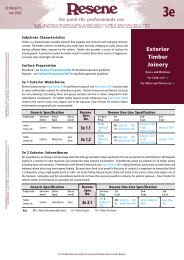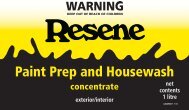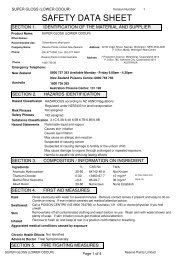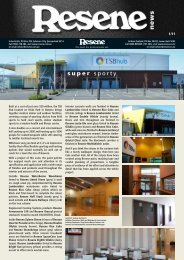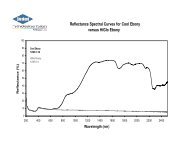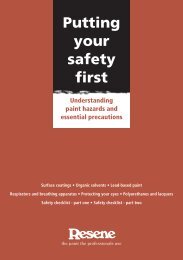Data sheet for D50a Resene Waterborne Colorwood natural wood ...
Data sheet for D50a Resene Waterborne Colorwood natural wood ...
Data sheet for D50a Resene Waterborne Colorwood natural wood ...
You also want an ePaper? Increase the reach of your titles
YUMPU automatically turns print PDFs into web optimized ePapers that Google loves.
May 2011<br />
<strong>D50a</strong><br />
<strong>Resene</strong><br />
<strong>Waterborne</strong><br />
<strong>Color<strong>wood</strong></strong><br />
<strong>natural</strong> <strong>wood</strong> stain<br />
<strong>Resene</strong> <strong>Waterborne</strong> <strong>Color<strong>wood</strong></strong> is<br />
an exciting way of treating <strong>natural</strong><br />
timbers and enhancing the grain.<br />
Gives coloured timbers with the<br />
see-through look as it allows the<br />
<strong>natural</strong> grain of all timbers to<br />
show through.<br />
interior<br />
Typical uses<br />
• Canework<br />
• Cork<br />
• Doors<br />
• Dressed and rough sawn<br />
timber<br />
• Fibre and particle board<br />
• Furniture<br />
• Kitset and nursery furniture<br />
• Panelling<br />
• Rope<br />
• Timber (imported and native)<br />
• Timber ceilings and beams<br />
• Window and door frames<br />
Please ensure the current <strong>Data</strong> Sheet<br />
and Safety <strong>Data</strong> Sheet are consulted<br />
prior to specification or application of<br />
product. If in doubt contact <strong>Resene</strong>.<br />
Vehicle type<br />
Pigmentation<br />
Solvent<br />
Finish<br />
Colour<br />
Dry time (minimum)<br />
Recoat time (minimum)<br />
Primer required<br />
Theoretical coverage<br />
Dry film thickness<br />
Usual no. of coats<br />
Overcoat required<br />
Chemical resistance<br />
Heat resistance<br />
Solvent resistance<br />
Durability<br />
Thinning and clean up<br />
VOC<br />
Per<strong>for</strong>mance<br />
Limitations<br />
Physical properties<br />
Urethane type<br />
Light fast transparent pigments<br />
Water<br />
Low sheen<br />
Standard; range of traditional <strong>wood</strong> finishes, limed<br />
and bright colours<br />
4 hours<br />
4 hours dependent on timber type, application rate<br />
and varnish<br />
No<br />
10-14 sq. metres per litre<br />
Penetrating type<br />
1<br />
Yes<br />
Excellent<br />
100°C<br />
Good<br />
Excellent (light fastness)<br />
Thin with <strong>Resene</strong> <strong>Waterborne</strong> <strong>Color<strong>wood</strong></strong> Reducing<br />
Base; clean up in water when wet and mineral turps<br />
when dry but uncured<br />
c. 90 grams per litre (see <strong>Resene</strong> VOC Summary)<br />
Per<strong>for</strong>mance and limitations<br />
1. Ease of application and long wet edge ensures<br />
no lapmarks.<br />
2. All colours can be intermixed.<br />
3. Available in bright colours to give an extra<br />
dimension to timber.<br />
4. May be overcoated with <strong>Resene</strong> Qristal Clear<br />
Polyurethane (see <strong>Data</strong> Sheet D52) or 48 hours<br />
with <strong>Resene</strong> Polythane (see <strong>Data</strong> Sheet D53),<br />
<strong>Resene</strong> Qristal ClearFloor (see <strong>Data</strong> Sheet<br />
D506 and <strong>Data</strong> Sheet D506A) or <strong>Resene</strong><br />
Aquaclear (see <strong>Data</strong> Sheet D59).<br />
5. An Environmental Choice approved product.<br />
1. Stir well be<strong>for</strong>e use. Allow adequate drying<br />
be<strong>for</strong>e applying varnish.<br />
2. Strong colours may be hard to achieve on<br />
hard<strong>wood</strong> and heart timber due to lack of<br />
penetration.<br />
3. Where penetration of the stain is difficult the dry<br />
time will be affected.<br />
4. <strong>Resene</strong> <strong>Waterborne</strong> <strong>Color<strong>wood</strong></strong> is designed to<br />
penetrate the surface and any excess must be<br />
wiped off. Failure to do so could result in lower<br />
adhesion of the subsequent varnish, especially<br />
<strong>Resene</strong> Polythane (see <strong>Data</strong> Sheet D53).<br />
5. Allow 24 hours drying be<strong>for</strong>e overcoating with<br />
<strong>Resene</strong> Qristal Clear Polyurethane (see <strong>Data</strong><br />
Sheet D52) or 48 hours with <strong>Resene</strong> Polythane<br />
(see <strong>Data</strong> Sheet D53), <strong>Resene</strong> Qristal<br />
ClearFloor (see <strong>Data</strong> Sheet D506 and <strong>Data</strong><br />
Sheet D506A) or <strong>Resene</strong> Aquaclear (see <strong>Data</strong><br />
Sheet D59).
<strong>Waterborne</strong> <strong>Color<strong>wood</strong></strong> <strong>natural</strong> <strong>wood</strong> stain<br />
Surface preparation<br />
Sand down thoroughly with fine paper and dust down. Ensure surface is free from oil, grease and glue. Any<br />
mark on the timber surface will show through <strong>Resene</strong> <strong>Waterborne</strong> <strong>Color<strong>wood</strong></strong>.<br />
Caution<br />
Sanding dusts from some hard<strong>wood</strong>s are considered carcinogenic and all old timber sanding dusts should<br />
be considered potentially harmful. Always wear an efficient dust mask.<br />
Sanding dust from old lead or chromate based paints or old building materials containing asbestos may be injurious to<br />
the health if inhaled or ingested. Seek expert advice if the presence of these materials is suspected.<br />
Application<br />
Best applied by brush.<br />
The finished colour is influenced by the colour of the timber itself. Always test <strong>Resene</strong> <strong>Waterborne</strong><br />
<strong>Color<strong>wood</strong></strong> on a small off-cut of timber to ensure you are achieving the desired colour. If the selected colour<br />
is too strong, reduce only with <strong>Resene</strong> <strong>Waterborne</strong> <strong>Color<strong>wood</strong></strong> Reducing Base. The colour strength will be<br />
determined by the length of time the stain is left be<strong>for</strong>e the excess is wiped off. This will also vary between<br />
dense and absorbent timber.<br />
1. Apply one full coat of <strong>Resene</strong> <strong>Waterborne</strong> <strong>Color<strong>wood</strong></strong> and wipe off excess with a dry absorbent cloth,<br />
rubbing with the grain.<br />
2. Fill up all nailholes with filler or putty matched to the appropriate colour.<br />
3. Apply three coats of varnish. If using <strong>Resene</strong> Qristal Clear Polyurethane (see <strong>Data</strong> Sheet D52), a first<br />
coat of <strong>Resene</strong> Qristal Clear Poly-Flat is recommended to ensure best holdout. Allow 12 hours between<br />
coats.<br />
For best results, wipe excess <strong>Resene</strong> <strong>Waterborne</strong> <strong>Color<strong>wood</strong></strong> off with a dry, absorbent and lint-free cloth,<br />
rubbing along the grain. This also ensures maximum adhesion of topcoats.<br />
Please ensure the current <strong>Data</strong> Sheet is consulted prior to specification or application of <strong>Resene</strong> products.<br />
If the surface you propose to coat is not referred to by this <strong>Data</strong> Sheet, please contact <strong>Resene</strong> <strong>for</strong> clarification.<br />
In Australia<br />
PO Box 785, Ashmore City, Queensland 4214<br />
Call 1800 738 383, visit www.resene.com.au<br />
or email advice@resene.com.au<br />
In New Zealand<br />
PO Box 38242, Wellington Mail Centre, Lower Hutt 5045<br />
Call 0800 RESENE (737 363), visit www.resene.co.nz<br />
or email advice@resene.co.nz<br />
Printed on environmentally responsible paper, which complies with the requirements of environmental management systems EMAS and ISO14001. Please recycle.


